We wanted to share a little sample of some of the FABULOUS art continues to be submitted for this year’s Biennial Project Biennial to be presented on our website and via video projection at the Venice Biennial 2022 Opening week!
Feast your eyes on a selection of this beautiful work:



Lorraine Motel, No Justice No Peace, and Seat at the Table, by Al Harden


Eternal frost and Scents for Forgotten Countries, by Anna Novakov


Arctic Pending: Surrender and Arctic Pending: Arctic Thaw, by Eileen Wold




Gaia Rise, The Perseids, Melancholia and Rape of Medusa, by Artemis Herber


Adinkrahene and Cymbal and Machine Noire, by Marcus Brown



John the Baptist, copresence and A Glorified Approach to Violence, by Matthew Keller


Ofrenda – a walking project and For The Forest, by Maria Villanueva


Memories of Family and Stories Told and Stories from the Photo Album, by Wendell Brown
The German Christmas markets sparkle in the European landscape as places where reality can be suspended and grown-ups can be kids again. Central Berlin alone has 10 Christmas markets, each market with its own personality. They run from late November to early January.
There are constants: Twinkling rows of small shops bring crafts and specialty street-foods from all over the country. Sausages sizzle. Beer foams. Wonderful smells waft. Gingerbread morphs into festive shapes. Some markets even have ice-skating rinks, amusement-park rides, and carnival games of chance.
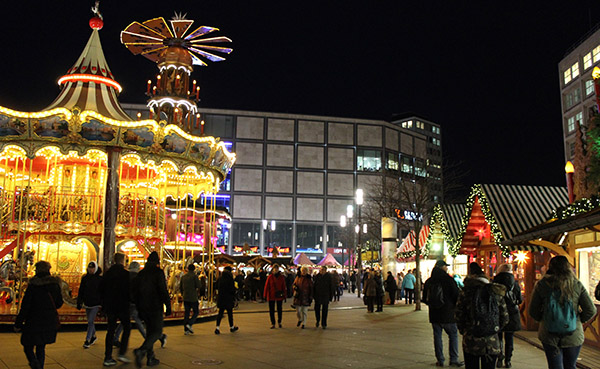

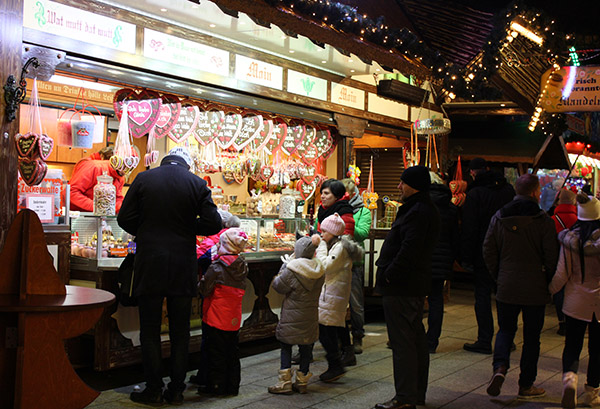 Drinks are plentiful, the Glühwein (hot mulled wine) and hot rum grog are most popular because it is cold outside, and most drinking places are outdoors, around circular fire pits or at long tables. My modus operandi is strolling among crowds with a mug of Glühwein or a package of hot roasted chestnuts, or sitting at a fire pit.
Drinks are plentiful, the Glühwein (hot mulled wine) and hot rum grog are most popular because it is cold outside, and most drinking places are outdoors, around circular fire pits or at long tables. My modus operandi is strolling among crowds with a mug of Glühwein or a package of hot roasted chestnuts, or sitting at a fire pit.
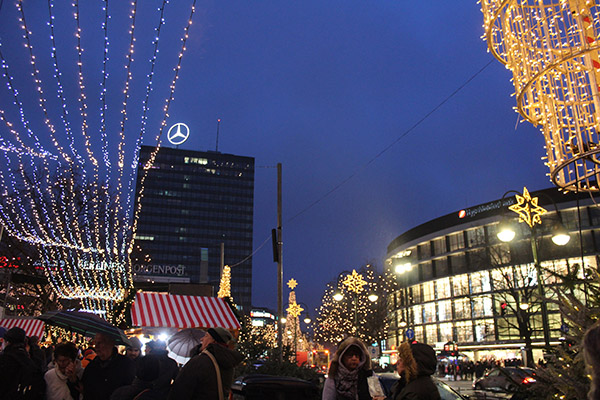
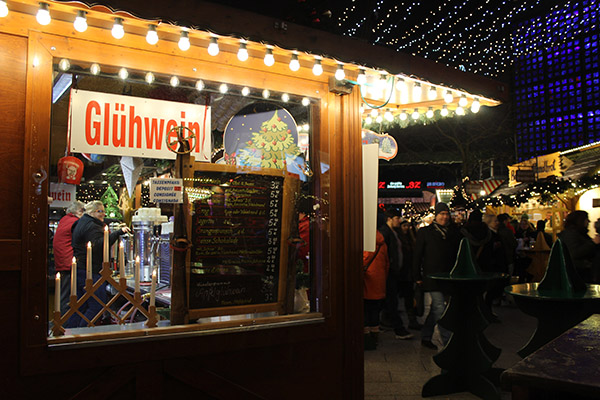

My favorite market is at Alexanderplatz, where there is a giant Pyramide with life-size Mary, Baby J, Joseph, shepards, and kings revolving on a 5-story-tall replica of a common German Christmas table-top decoration, which at home has tiny tiers propelled by candle heat. The ground level of Berlin’s monstrous Pyramide is a beer garden, the second tier is a restaurant.
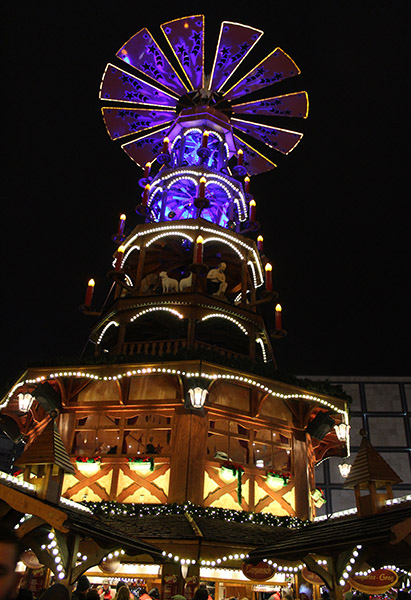
The Berlin Christmas markets are kitschy and crass, but within bounds. The mood seems a mix of merriment and nostalgia. Little kids are ecstatic with all the lights and movement, and adults are ready to drift into a realm of holidays long past with hope for the future. This is maybe why the killings at last year’s Berlin Christmas market seemed especially brutal. Its one-year day of remembrance happened this week in Berlin, and the observance was not without controversy.
When the attacker last year on Dec. 19th drove a 25-ton truck into the Christmas Market at Breitscheidplatz quickly killing 12 people and injuring 70 more, prime minister Angela Merkel herself seemed like a doe caught in the headlights.
She was blamed for the terror by the right wing for having allowed so many immigrants into the country (the driver of the truck was from Tunisia), and she was criticized from the left wing for showing so little compassion toward the victims and their families. She did not meet with the families after the attack. She did not write them personal letters. She did not offer government-funded reparation or funeral costs.
It’s not like terror is unknown in Germany. The 20th century Germans unleashed much of their own on the world. But since the 1972 terror attack at the Olympic Games in Munich, which now seems long ago, modern Germany has gotten off easier than many other countries in terms of this sort of violence. Frankly, Merkel has had little practice in dealing with terrorism on her own turf.

On Tuesday of this week, Merkel visited the site of the killings, where an elegant and unusual monument to the victims was unveiled (see next blog entry on artistic monuments to terror) and where fresh flowers and candles have been constant since a year ago. The Christmas market was shut down that day for the ceremonies. Bells tolled in the Gedächtniskirche – the Church of Rembrance of WW II events, on the steps of which the truck driver had mowed down the 12 victims. On Wednesday, Merkel finally met with the families of the killed and the injured, and talked with them for 3 hours. Overdue, but kind.
In the past Germans have been critical of the way some nations report terrorist events – nations that name and lionize the perpetrators, and leave the victims nameless. In response to this act of terror, German journalists have made a point of naming all 12 victims in each coverage of the event. I will do it, too: Anna Bagratuni, Georgiy Bagratuni, Sebastian Berlin, Nad’a Cizmár, Dalia Elyakim, Christoph Herrlich, Klaus Jacob, Angelika Klösters, Dorit Krebs, Fabrizia Di Lorenzo, Lukasz Urban, Peter Völker.
Three-foot high, one-ton sections of concrete barrier now encircle the same market and life goes on in a bent direction.

May our celebration of the new season, the new year, in any holiday form we choose, signify a fresh start for us all.
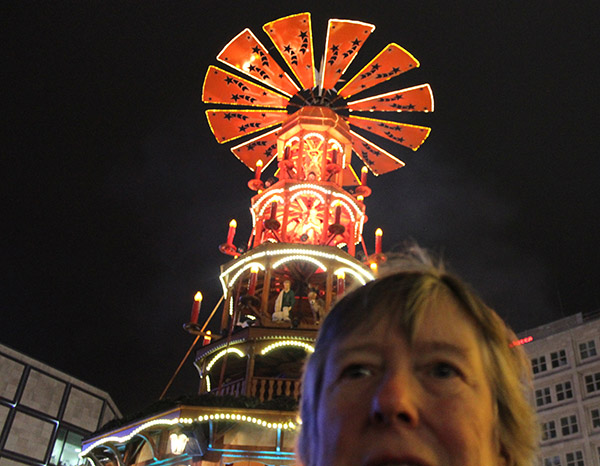
X Bonnie Woods
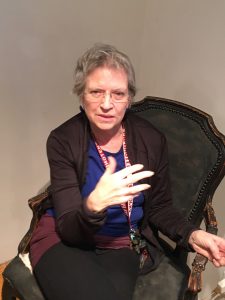
In the gallery with Charlene Liska, 2017
In the Silent. Silence. Silenced. exhibit at Atlantic Works Gallery, Charlene Liska sets up a Plato’s Cave, of sorts, using video and installation. Gallery visitors can see faces of the artist’s tribe on one screen and hear the echos of what they are saying–via deliberate use of headphone assistance– on a second screen in a different location in the gallery. At the same time the sound of silence–rather, what Liska offers as silence–is a bird’s chirping which permeates the gallery’s audio atmosphere. What the gallery-goer does not immediately realize: the bird chirping is mimicry of the real thing; a sound made by Liska’s Brazilian electrician, Elson.
Using the concept of Silence as the springboard, Liska plays with the possibilities of form and organization, flat planes, shadows, dimension and her own wit, imagination and experience.
“I see Silence as having two sides,” she says. “There’s the beautiful, spiritual and eternal. We are all seeking that and desperately want that kind of silence. And then there is the psychological side.
“Psychologically we’re all being silenced by too much noise. Too much data. It’s flooding in on us constantly.”
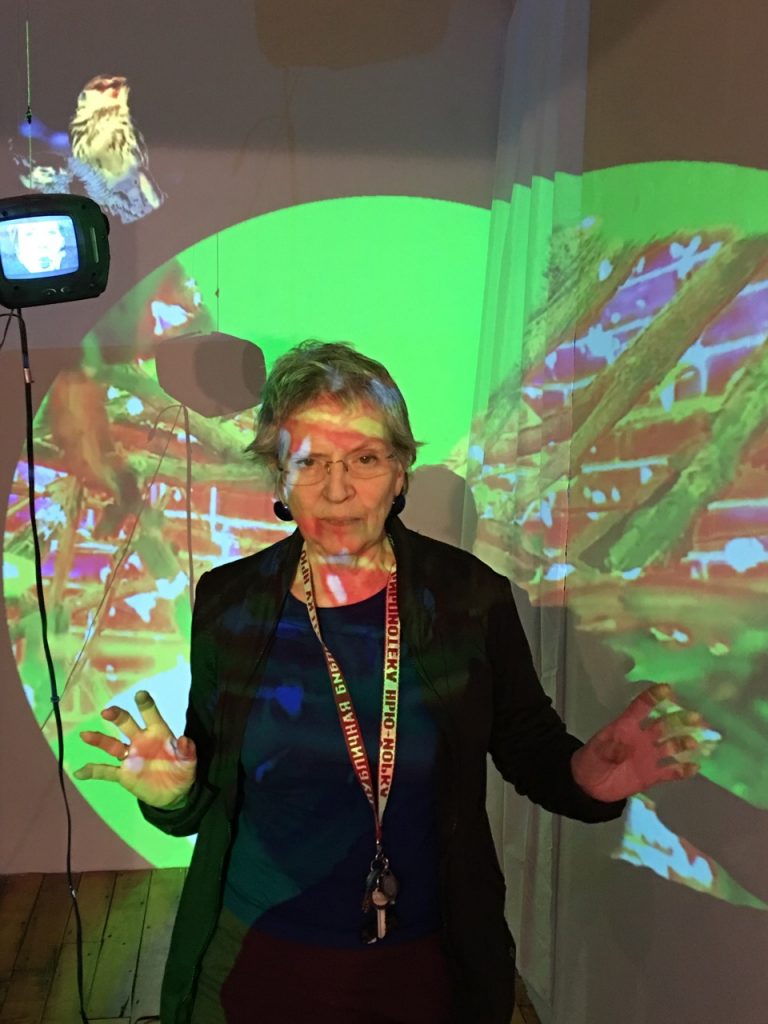
Artist Charlene Liska and her ‘Diorama’ installation at Silent. Silence. Silenced exhibit November 2107.
The far-side of the gallery houses her curtained-off installation Diorama. Liska creates a layered and a sculptural space that features her own image–talking but without sound–captured within a very small 3-d TV that hangs about six feet above the floor. A projection of a green shrub and brick wall hit and flash on the monitor. The green and red images reach back further, to the flat wall which is about 6 feet behind the suspended TV. The green flashes, changing shape, morphs. In the upper left corner, is a video cameo of a Boreal Warbler that seemingly watches over the pulsing installation.
“I have tremendous sensitivity to flashing light,” Liska said. “I suffer seizures. Epilepsy.”
Liska explains that epilepsy was a cruel condition to have as a child because it made her feel alienated, self-vigliant and hypersensitive. “Beginning when I was about 13, going on through menopause–estrogen can push you over the edge!”
She hid the condition. In high school teachers and administrators threatened ‘if you have another one’ they would have to put her in an institution. “That meant insane asylum,” she adds. Her family felt strongly that she and they should not talk about her condition publicly.
“I don’t stay silent about it anymore, or hide it.” Liska explains. The episodes and experience certainly influenced her art.
For example, waking up from a seizure Liska would see heads hovering above her. “Heads similar to the heads in my video interviews.” Of course the heads were her husband’s and daughter’s; earlier on her family’s.
Liska has shot many ‘head-on interviews.’
“I did one on Occupy Boston. Another in Berlin on the Documenta. The first video I made was with Anna [Salmeron]. We interviewed gay people about their first kiss. It’s titled ‘Crush’.”
She laughs. “I’m attracted to people’s heads and what’s going on in there.”
In the Silent. Silence. Silenced video Prophecy I, Liska interviews and celebrates her tribe of Atlantic Works Gallery artists. She requested the interviewees wear hoodies, a form of silencing, and asked them about the future.”What do you think it will be like?” But you can’t hear the answers, unless you walk to the other side of the gallery, to Prophecy II, and put on headphones, or read the text pinned to an opposite wall. Gallery-goers, however, can see the deconstructed pulse of the language, like a line of a heart monitor, that captures the sound waves of the interviewees answers. “It’s media chaos,” she says about the separation of voice from image. “It’s taken for granted in our world, words can easily be drowned and depersonalized in data.”
In the back nook of the gallery, Liska’s 12- hour video, Border Night not only pays homage to the past–early video artist Andy Warhol– but also to current and future questions regarding privacy and surveillance.
“I wanted to grab the opportunity to make this video before everything on East Boston’s waterfront changes,” Liska says. So, one night in September 2017, Liska set up cameras in her Border Street studio window and shot a dusk to dawn look at East Boston’s waterfront.
In addition, at the Silent, Silence Silenced exhibit, Liska shows archival prints: Newfoundland Bogs (from her time in Canada); Convent, Ghent; and Mojave Whistlestop.

Atlantic Works Gallery artist Charlene Liska in front of “Prophecy I Machine Transcription”: video, 2017 (image on screen is Elson, the Bird Caller)
There is not complete Silence in the gallery. We hear bird noises. “So many people associate silence to birdcalls,” Liska says. So she came up with bird sounds–a witty twistaroonee, of course: sounds made by her Brazilian electrician who has a knack for imitating and relating to birds. “They talk to him. He talks to them,” she says.
“When you go into the countryside to record silence, you get birdcalls. Even when you are not looking for them, there they are. It’s like birds live in a parallel universe. Their spirits fly and they don’t care what we do. They just go on and on. Unaffected.” She nods. “Birds are stronger than we are.”
Finally, going back to Platos Cave: the ‘prisoners’ in the cave perceived only shadows and echoes of real objects and were completely unaware that those forms were not the real thing. Ultimately, according to Plato, their perception was not false; by their understanding of the world, the shadows and echoes were the actual forms, since this was all they knew.
In ‘Liska’s Cave’, an ode to Silence, the world’s transition to a socially connected, digital society—the age of the internet–nudges the viewer to contemplate modern reality, and the shadows it casts on form. Here, in the gallery, the major form is video screens. And use of the form questions the separation of words from their speaker, the transformation of spoken text into paper flatness; the absence and ability to inject new words within the movement of a silenced mouth; and even the manipulation of self presentation.
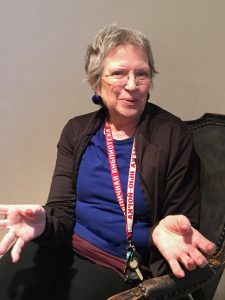
In the gallery with Charlene Liska, 2017
“I do art because I like to do it,” Liska said. “I make art to make art, for no other reason.”
We can think of Liska as the bird in the corner of the gallery in Silent. Silence. Silenced. watching over the video screens. The sound of her voice has cast strong shadows that challenge our questions about the future and what we might choose to make or take from the video screen.

Woman in abaya at November 4, 2017, Opening reception of Silent. Silence. Silenced.
For the Silent. Silence. Silenced exhibit at Atlantic works, I showed a grouping of black & white monoprints of hooded heads that many gallery visitors said were fascinating. At the artist talk, one of the guests thought the row of prints reminded her of Crusaders.
It was a long haul through self-censorship for me to show the monoprints, because more than one of my yoga associates told me they would not come to the exhibit or send any students to the exhibit to see the hooded images because they were too ISIS and too upsetting.
Up until those conversations, with people I admire and am grateful to have in my life, it hadn’t occurred to me that I ought to sequester the images so the public would have a choice of whether or not to look at them. But I began to silence myself. Self-censor. Maybe I shouldn’t show them. Maybe the black hooded heads would upset people. Maybe I would be perceived as politically incorrect or a racist.
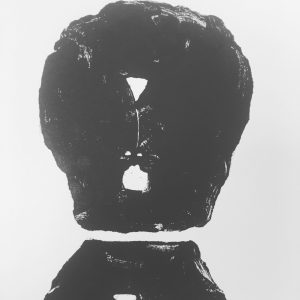
B & W monoprint
Consequently, as a way of working out my artistic dilemma, I made gold hooded heads and called them “Silenced by Capitalism.” For some reason, I was sure the concept and the sculptures of female heads tightly shrouded in gold would not be upsetting to anyone.
More conversations. With Charlene Liska who said “Don’t self-censor.” In conversation with fellow artist Brenda Star who said, “Art is supposed to get people to think about what’s going on, around them. How are people going to become aware if they are protected from images, from art?”
Art is always a process. Often I know what I am thinking about when I work. I know how I started thinking and when I finish I know more about what I am thinking.
This is the story of the monoprints:
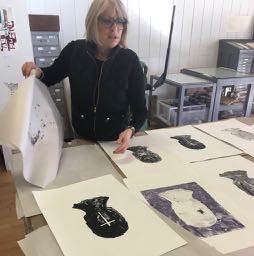
Christine Palamidessi printing Black Hooded mono prints.
In the winter of 2017 I was artist in residence at Mass MoCA in North Adams, working on the printing press at Maker’s Mill. I was doing mono prints of the head of the Greek Goddess Nike, the image being based on the 420 BC bronze head of the goddess (now viewable in Athen’s Agora Museum). I thought I was exploring the imprints of antiquity on modern life and the meaning behind the Goddess: from the Victorious Female who rode in the chariot next to Zeus to a word and a swish on a sneaker. In addition I was exploring the meaning and hallucination that goes along with looking at a ‘head,” particularly the image of the first head we humans see and become visually attached to—the head of the mother who looks over the infant.
On the second or third day, I turned onn the radio. Our U.S. Senate had gathered to discuss Trump’s attorney general pick, Jeff Sessions. As I inked and pressed, Senator Elizabeth Warren read a letter, written by Martin Luther King Jr’s widow Coretta Scott King. The letter detailed Session’s history of racism and civil rights violations. The Speaker of the House shut Warren down; the Senate voted to silence her.
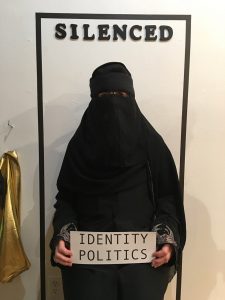
Silenced by Identity Politics
That was truly upsetting new for me. I dropped a black inked hood over the face of Nike; and I kept going. A portion of the monoprints, made when the artist was upset about a silenced woman, are on exhibit at SILENT. SILENCE. SILENCED. at Atlantic Works Gallery .
This is the process. We use our skills, our sensitivity, our history, our bodies. and react to social, political and aesthetic conditions in our environment.
The black, hooded icon consumed my work for several days, initially expressing censorship; female censorship; and then moving on to reference images of racism, terrorism, and public degradation, execution, religion, and war as realized by a simple, stark, isolated hooded black face.
A hood/sack placed over a human head silences; humiliates; deprives a person of soul and individuality, while at the same time identifies that person as a single member of an oppressed group exploited by those more powerful.
I began thinking of a Female Goddess, Victory, who then became Silenced, who then became a an meditative icon. An image is in effect in service to power. No one has ever cut off your head or mine. You are like me: a human being who speaks, an artist.

“IF THEY WANT POSTCARDS, I MAKE POSTCARDS”
For the Silent. Silence. Silenced. show at Atlantic Works Gallery, Charlene Liska and I worked together to come up with an attractive and informative post card that would serve multiple purposes:
- A Hand-out to give friends and family.
- An immediate mailer/invitation. There’s no envelope to open.
- A good-looking ‘small flyer’ for us, fellow artist friends, and student volunteers to leave at coffee shops and to pin on announcement boards at museums, cultural organizations, and student centers, etc.
- A calling card for when we visit galleries this month.
- A possible bookmark and legacy stash.

Front of Charlene Liska’s postcard for Silent. Silence. Silenced.
Decisions to make before designing an Art Exhibit Post Card.
- What’s on the Front? Usually an image. Could be words.
- What Goes on the Back? Who-What-When-Where ( more later).
- Size. To qualify for First-Class Mail postcard rate the card has to be rectangular, at least 3-1/2 inches high x 5 inches long x 0.007 inch thick and be no more than 4-1/4 inches high x 6 inches long x 0.016 inches thick.
- Print Run. How many to print?
- Budget. How much money you have to spend on this aspect of promotion//marketing?
As far as print run: we decided to print 500 postcards and print two different front images. We shared identical print information on the back of the post card and varied the image on the front 250/250.
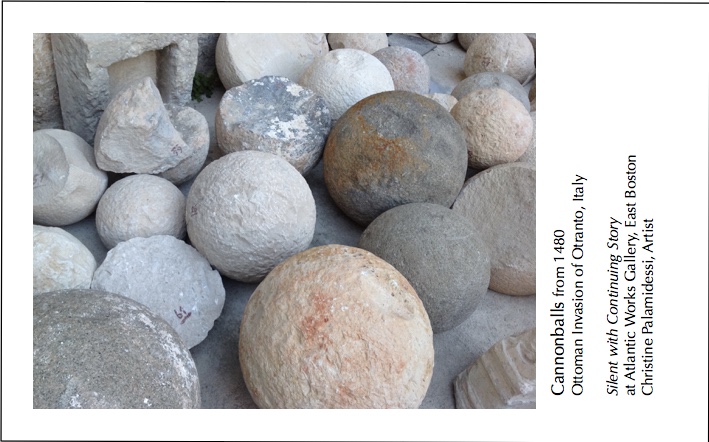
Front of Christine Palamidessi post card for Silent. Silence. Silenced.
Finally, here are the five main points to keep in mind when putting your post card all together:
- Plan ahead. Have the postcards ready 1-2 months before your show opens. This means not only do you need to design the card, but communicate with your printer to find out his/her lead time. So work backwards from your desired date of having the post-card in hand and then line up all the things you need to do to make it happen.
- Who. What. When and Where. Yes, you’ve heard this before and you’ll hear it again. Who (your name) What (name of show and definition of show–is it a pop-up, a month-longshow, a one nighter?) When (the run date of the show as well as the date of the Opening Night and any other special events during the run of the show) Where (name of the gallery, or venue, and the address. Include zip code and phone number of the gallery and the gallery/venue website. You may consider putting your own phone number on the card, as Charlene and I did, but realize your phone number may end up on someone’s solicitation list.
- Establish Credibility. Be sure to proofread everything. Use high resolution photos/jpg. A sloppy looking card communicates ‘a don’t care/don’t know/I make mistakes attitude’ — which you probably don’t want to do unless that’s the theme of your exhibit, which has its own set of decisions and contradictions not addressed here.
- Keep It Clean and Easy. Fewer words are better than a lot of words. People appreciate quick-to-eye grab information. (look at image below–left side of the back of postcard) to see how we varied caps and lower case, as well as grey and black inks.)
- Ask Friends and Art Community to Help Spread the Word & Distribute Your Post Cards (drop off, mail, post in their place of work) .


